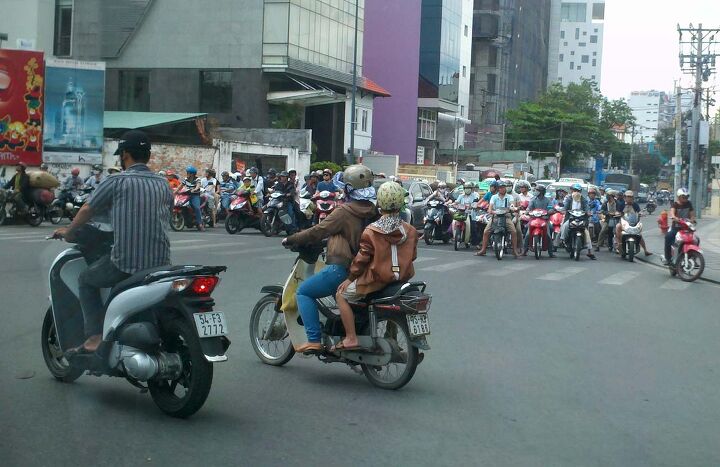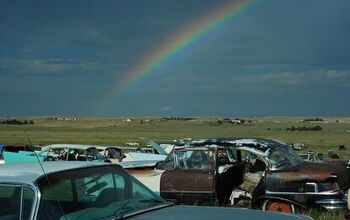How Honda Survived the Vigor, the Del Sol, and the Lawsuits: Super Cub!

For about 15 years, the Civic and the Accord were untouchable in the American marketplace; Honda sold all they could build here plus as many as they could import under the limitations of the Voluntary Export Restraint agreement of 1981. Then… well, Soichiro Honda died and Honda sort of lost its way. Sure, their cars were still good, but the competition had caught up and the Honda magic had worn off for American car buyers. Honda car sales in Japan had never been so great, so what kept Honda going through the lean times? Two-wheelers! I spent two weeks in Vietnam last month and came away with a new appreciation for Honda’s utter dominance of the Asian motorbike market.
Scooters and motorcycles are central to the culture of Vietnam; farmers ride them to their fields, parents use them to drop the kids off at school, furniture stores use them to deliver bedroom sets, and so on. Saigon and Hanoi are boiling maelstroms of bikes everywhere. Want to ride on the wrong side of the street? Go for it! On the sidewalk? Sure! Traffic signals? What traffic signals? Most of the bikes are sub-200cc machines, most are clutchless, and most are Hondas. The Honda Wave is one of the most popular, with the newer Air Blade a big seller as well. Those shiny new bikes were kind of interesting, but nothing approaches the majesty of the most-produced motor vehicle in history: the Honda Super Cub.
If you see a motorcycle piled high with an outlandish quantity of weird stuff in Vietnam, there’s about a 90% chance that it will one of the 60+ million Super Cubs built since 1958.
Hauling 150 kilos of soybeans to your restaurant in Danang? You know what to do!
As James May says in the Top Gear Vietnam Special, after selecting a Super Cub for his Saigon-to-Hanoi steed, this is the machine that put Asia on wheels.
You see a lot of completely beat early Super Cubs in Vietnam, no doubt pieced together from bits of several junked bikes. The Vietnamese I spoke to about the Super Cub were a little puzzled by my interest; to them, the old Super Cub seems to be your entry-level bike, something you sell as soon as you can afford to move up to a Wave or Vespa.
Which isn’t to say that you don’t see early Super Cubs in cherry condition. The owner of this one, parked in front of the Saigon tailor shop where I had some custom shirts made, protects the seat from sun and grime with a plastic stool while parked.
The Super Cub is the real business workhorse of the country. While Toyota Innova minivans are getting more popular for deliveries, the venerable Honda motorbike still rules the narrow streets of Vietnam. Here’s a trailer-equipped Super Cub serving as a beer truck in Hoi An.
It’s good to know that my frosty Biere Larue was brought to this excellent restaurant on a Super Cub. Vietnam is still a regional-beer place, with Danang-brewed Larue the top beer in the central part of the country.
Adding a trailer to your Super Cub makes it tougher to negotiate traffic, but saves time tying stuff down and makes it easier to balance while riding.
It’s easy to find parts for your ailing Super Cub in Saigon and Hanoi; little hole-in-the-wall shops sell every component imaginable. I asked several semi-English-speaking street-corner mechanics (more on them later) about motorbike junkyards, but nobody seemed to understand my question.
You can still buy new Super Cubs, and many do. The Little Cub seems especially popular among young women with office jobs.
The Super Cub was sold in the United States, but the Piper Super Cub airplane meant that Honda had to use a different name on these shores. So, Americans bought Honda Passports.
I’ve never owned a motorcycle in my life, but I’m now shopping for an old Passport. If I find a good one, I’ll head over to eBay and buy some Super Cub badges for it.

Murilee Martin is the pen name of Phil Greden, a writer who has lived in Minnesota, California, Georgia and (now) Colorado. He has toiled at copywriting, technical writing, junkmail writing, fiction writing and now automotive writing. He has owned many terrible vehicles and some good ones. He spends a great deal of time in self-service junkyards. These days, he writes for publications including Autoweek, Autoblog, Hagerty, The Truth About Cars and Capital One.
More by Murilee Martin
Latest Car Reviews
Read moreLatest Product Reviews
Read moreRecent Comments
- Lorenzo I just noticed the 1954 Ford Customline V8 has the same exterior dimensions, but better legroom, shoulder room, hip room, a V8 engine, and a trunk lid. It sold, with Fordomatic, for $21,500, inflation adjusted.
- Lorenzo They won't be sold just in Beverly Hills - there's a Nieman-Marcus in nearly every big city. When they're finally junked, the transfer case will be first to be salvaged, since it'll be unused.
- Ltcmgm78 Just what we need to do: add more EVs that require a charging station! We own a Volt. We charge at home. We bought the Volt off-lease. We're retired and can do all our daily errands without burning any gasoline. For us this works, but we no longer have a work commute.
- Michael S6 Given the choice between the Hornet R/T and the Alfa, I'd pick an Uber.
- Michael S6 Nissan seems to be doing well at the low end of the market with their small cars and cuv. Competitiveness evaporates as you move up to larger size cars and suvs.












































































Comments
Join the conversation
My wife has a 2010 Honda SH150i scooter. It is a blast around town. Easy to ride. Quick on\off for errands, versus my much bigger moto. And rated at 91 MPG. The thing is super reliable.
I love my little 1973 CT90. It's the "off-ish road" version. Everyone should have one of these. One cylinder, 4 stroke, it can teach you EVERYTHING you need to know about maintenance owning one of these lill' buggers!